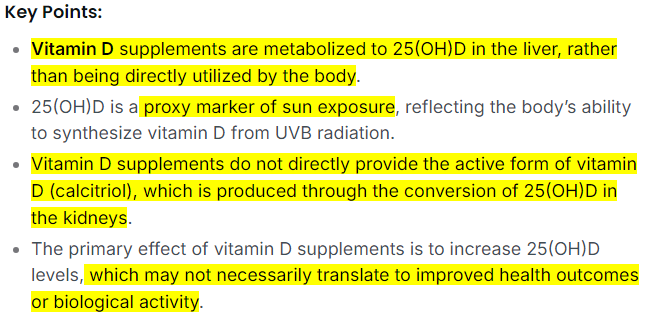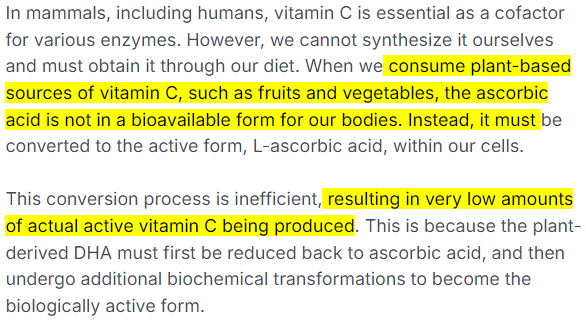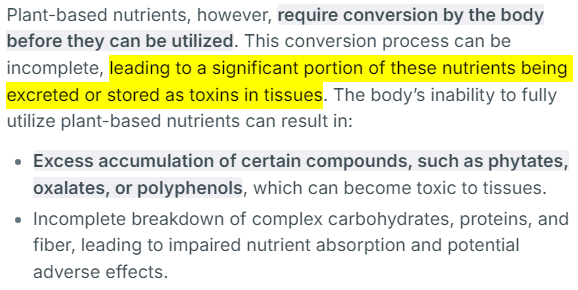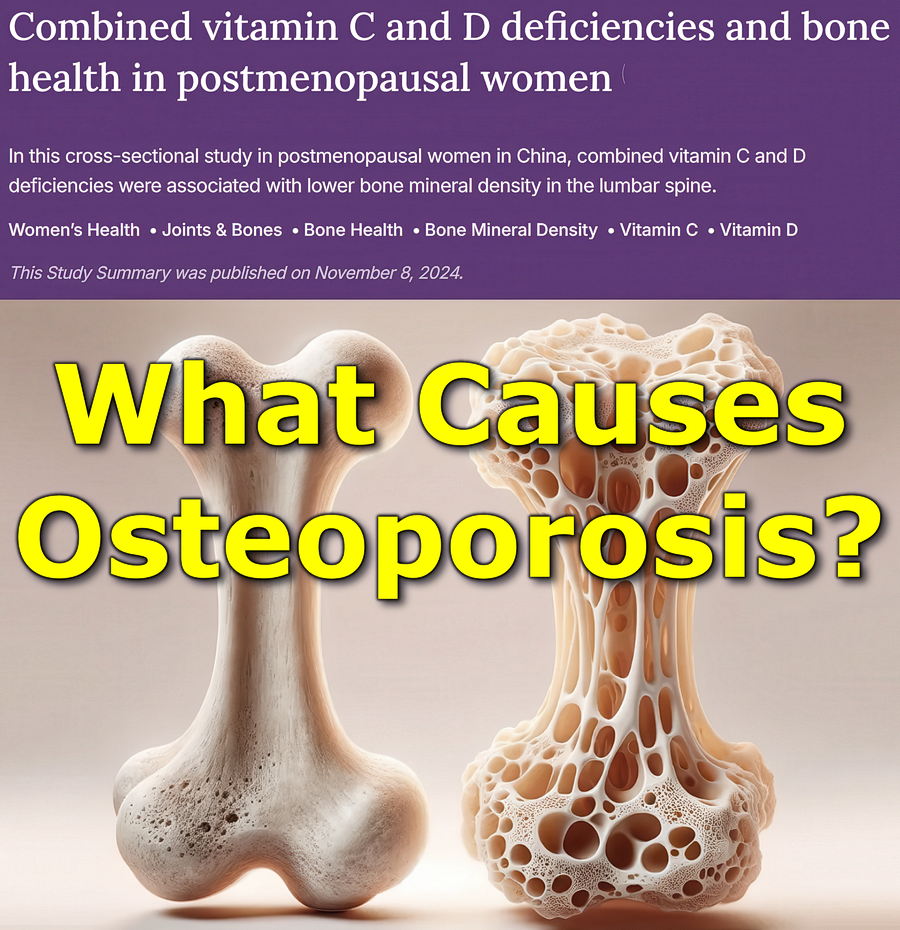Today we visit Examine.com, a website dedicated to review and “analyze” the latest “scientific research,” with an extra focus on nutrition and supplementation (which is extremely toxic and dangerous.) While they lack the knowledge and experience to actually do what they claim, it’s still a good source to keep track of all the studies and research papers being published within these pseudo-scientific fields — and simply from Examine’s summary, you can tell if it’s complete bullshit or simply vague bullshit.
For this article, Examine summarized a cross-sectional study in postmenopausal women in China, where a combined vitamin C and D deficiency were associated with lower bone mineral density in the lumbar spine. And while Examine does not really comment on the study, it gives me the opportunity to explain a few things about these “vitamins” and bone health in general. So, let’s get moving.
Quick Summary
“In this cross-sectional study in postmenopausal women in China, combined vitamin C and D deficiencies were associated with lower bone mineral density in the lumbar spine.”
I’m not really sure why they wasted money and time on such a study as it’s been known for ages that Vitamin C and also Vitamin D plays crucial roles in bone health, especially collagen synthesis, which represents 30% of bone tissue.
The study mentioned is the following:
He L, Chhantyal K, Chen Z, Zhu R, Zhang L. The association of combined vitamin C and D deficiency with bone mineral density and vertebral fracture. J Orthop Surg Res.(2024 Aug 2.)
What was studied?
“The relationship between vitamin C and D deficiencies (alone or combined) and bone mineral density (BMD) in postmenopausal women.
Dual-energy X-ray absorptiometry (DXA) was used to assess BMD of the lumbar spine, femoral neck, and hip regions. The participants’ T-scores were also calculated. T-scores indicate how many standard deviations the current BMD is from the peak BMD of healthy young individuals of the same gender.”
The results should be obvious as both vitamins are important for bone health and regeneration. Either deficiency should show signs of lower bone mass and a combined deficiency should thus show an even lower amount of bone mass.
Who was studied?
“99 postmenopausal women (average age of 67) with osteoporosis (91% of participants) and/or osteoporotic vertebral fractures (74% of participants).”
In other words, they studied women who had already been diagnosed with a decrease in bone mineral density and bone mass, leading to fragile and porous bones — a “condition” labeled as osteoporosis.
How was it studied?
“This cross-sectional study was conducted at a university hospital in China. The participants were categorized as having vitamin C deficiency alone, vitamin D deficiency alone, combined vitamin C and D deficiencies, or no deficiencies in either vitamin C or D (control group).
Vitamin D deficiency was defined as serum levels of less than 20 ng/mL, and vitamin C deficiency was defined as serum levels of less than 34 μmol/mL.
The prevalences of osteoporosis and fractures were also compared across groups.”
Keep in mind that serum levels of vitamin D are actually a proxy marker for sun exposure. If you supplement with toxic vitamin D supplements, this proxy marker will rise, but your body has not been exposed to the benefits of the sun. This will deceive the body to activate certain processes that are needed when being exposed to sunlight, including upregulating the production of certain hormones. But since there was no sun exposure, only a supplementation of fake and toxic vitamin D, there will be very severe consequences down the road, not to mention that vitamin D as a supplement is extremely toxic in itself, causing great tissue damage. I’ve covered this many times.



So, blood/serum levels of vitamin D have nothing to do with the actual vitamin/hormone vitamin D that you can only obtain from sun exposure or by consuming animal-based foods.
However, if you have been taking vitamin D supplements, the blood/serum levels will tell you absolutely nothing, as they have been artificially raised without any of the health benefits from real vitamin D as in sun exposure and obtaining it from animal-based foods — and this is of course really dangerous. And again, vitamin D from any plant is just as chemically different and useless for the human body.






As for the proxy marker, it’s still useful if you haven’t touched a supplement, as it tells you that you either do not get outside enough and/or your diet sucks and you need to consume more animal-based foods. The recognized level of Vitamin D deficiency is at 20ng/mL and below, and at 10ng/mL and below, the deficiency is considered severe and life threatening.
Vitamin C is just as tricky, if not trickier. As with vitamin D, you can only obtain vitamin C from animal-based foods. While there is some vitamin C (dehydroascorbic acid ) in a few fruits and vegetables, that vitamin C is in another chemical form and has to be converted by the body, and this presents a huge problem for any kind of blood/serum test. If you have a highly working brain (as in being a carnivore,) you have already figured this out (and I have mentioned it in several articles in the past.)


Since every single vitamin and mineral found in any plant-based food or supplement are not bioavailable, as in the wrong chemical form, as in “inorganic,” it has to be converted. This process, if you are healthy and fully nourished, yields a result between 10 and 80%, with most vitamins and minerals coming in at between 20 and 40% or so. Also, this is tricky to measure, as a lot of the inorganic non-useful vitamins and minerals will attach to tissues causing damage. So, whatever your body expels is not a real indicator of what remained and was used by the body.

Some of it might have been converted and used while a lot of it simply attached to tissues as a toxin. This also means that the conversion rates might actually be much lower in real life. And to add insult to injury, if you have a nutrient deficiency, or if your health is compromised, as in most people today, your body will have an even tougher time converting any inorganic nutrients to its bioavailable organic form. Hence, you might only get a few percent of the few vitamins or minerals actually present in that toxic plant-based garbage you just chewed down.

And again, this means that if you take a blood sample, both the unconverted and the converted vitamin or mineral will be measured. However, only the converted and now bioavailable vitamin or mineral will be used by the body, the rest will only sit around causing oxidative damage to tissues and blood cells — or, as mentioned, they will attach themselves to tissues.
This is one of many reasons why you should never consume anything plant-based or processed. And it’s also the reason why blood tests will be totally skewed as soon as some retarded doctor or dietician advises you to take supplements or eat more vegetables, as these are sources of the wrong chemical form of these vitamins or minerals. It will raise blood concentrations, but mostly with useless nutrients that cannot be utilized by the body. And as these levels go up, you have no idea if you actually convert enough or not. In other words, you might still be deficient. The only thing you can know for sure is that you have increased the toxic load on the body, and thus cellular damage, especially to organs. And that is a guaranteed way to shorten your lifespan even further.

What were the results?
“In comparison with no deficiencies, vitamin C deficiency alone was associated with lower BMD of the lumbar spine.”
Yes, this is what I said at the beginning of the article. Vitamin C is a cofactor for the enzyme prolyl hydroxylase, which is essential for the synthesis of collagen. Also, it is suggested that Vitamin C is involved in bone metabolism, including osteoblast differentiation and bone remodeling.
As for vitamin C deficiency, it’s usually caused by consuming carbohydrates while not getting enough organic vitamin C from animal-based foods — which is quite common in today’s backwards society, especially among women, and that will lead to bone mineral loss, which will be noticeable once you grow older. This happens because vitamin C is needed as an antioxidant in carbohydrate (glucose) metabolism as glucose is very toxic for the body.

Also, while glucose and vitamin C have distinct transporters, there is some overlap in their transport mechanisms. For example, GLUT1 and GLUT3 can also transport DHA, the oxidized form of vitamin C, into cells, where it is used by the mitochondria and also is recycled. This overlap may suggest that certain cells or tissues use similar transport mechanisms for glucose and vitamin C. In other words, if you consume carbohydrates regularly, and several times a day, some cells will not get enough vitamin C as it’s being blocked by the constant oversaturation of glucose from carbohydrates.

Remember, humans are obligate hyper carnivores and we make our own glucose through gluconeogenesis. We should not consume carbohydrates at all.


“In comparison with no deficiencies, vitamin D deficiency alone was associated with lower (worse) T-scores in the lumbar spine.”
Yes, I also said that at the beginning of the article. And again, most people today do not get enough sun exposure nor consume near enough animal-based foods, hence a lack of real vitamin D. This leads to bone mineral loss, and over time, it will become serious. And among the elderly, this is accelerated as they spend even more time indoors and their diets are often even worse, really lacking in animal-based foods.
“In comparison with no deficiencies, combined vitamin C and D deficiencies were associated with lower BMD and lower T-scores in the lumbar spine, and in comparison with vitamin D deficiency alone, combined vitamin C and D deficiencies were associated with lower lumbar BMD.”
And yes, I said that too. It is very logical.
“In comparison with no deficiencies, the prevalence of lumbar osteoporosis was higher among the participants with vitamin D deficiency alone or with combined vitamin C and D deficiencies. The prevalence of fractures was similar across groups.”
Note that with “no deficiencies” they mean the control group, as in those with no deficiencies in vitamin C and/or vitamin D. With that said, as the subjects had osteoporosis, they certainly had other deficiencies which are associated with bone mineral loss, such as deficiencies in calcium, phosphorus, copper, iron and selenium — all of them nutrients that you can only find in major and bioavailable quantities in animal-based foods.


However, this highlights the importance of vitamin D, as in sun exposure and animal-based foods for bone health.
And that was it for Examine’s summary of this totally unnecessary study. And what we can learn from my ramblings is as usual that you never need to worry about these things if you follow our natural human species-specific carnivore diet. And especially not if you are somewhat active and spend some time outdoors, getting that sun exposure, as you should.
If you need help with any kind of health problems or transitioning from your current way of eating to our natural species-appropriate, species-specific way of eating, I’m available for both coaching and consultation.
Coaching and Consultation
And if you found the article and my insights helpful and enjoy my daily free information, please consider donating to help pay the webhosting bills and keep the site running. And if you’re interested in discussing and sharing information with likeminded people, consider joining our uncensored community at Ungovernable.se. Thank you!

